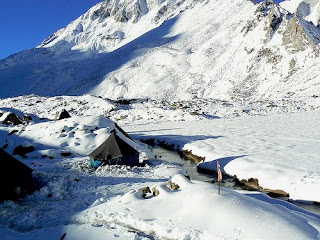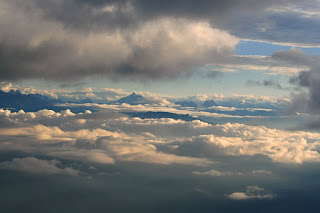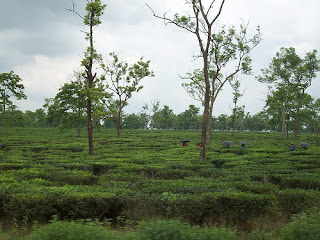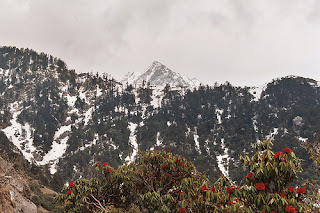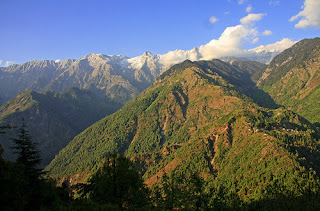About Mount Abu
Mount Abu is the highest peak in the Aravalli Range of Rajasthan state in western India. It is located in Sirohi district. Mount Abu is 58 km from Palanpur (Gujarat). The mountain forms a distinct rocky plateau 22 km long by 9 km wide. The highest peak on the mountain is Guru Shikhar, at 1,722 metres (5,650 ft) above sea level. It is referred to as 'an oasis in the desert', as its heights are home to rivers, lakes, waterfalls and evergreen forests. The ancient name of Mount Abu is "Arbudaanchal".
The Arbuda Mountains (Mount Abu) region is said to be original abode of the famous Gurjaras.The association of the Gurjars with the mountain is noticed in many inscriptions and epigraphs including Tilakamanjari of Dhanpala. These Gurjars (Gujars or Gujjars) migrated from Arbuda mountain region and as early as sixth century A.D, they set up one or more principalities in Rajasthan and Gujarat. Almost all or a larger part of Rajasthan and Gujarat had been known as Gurjaratra (country ruled or protected by the Gurjars) or Gurjarabhumi (land of the Gurjars) for centuries prior to Mughal period.
In the Puranas, the region has been referred to as Arbudaranya, ("forest of Arbhu") and 'Abu' is a dimunitive of this ancient name. It is believed that sage Vasishtha retired to the southern spur at Mount Abu following his differences with sage Vishvamitra. There is another mythology according to which a serpant named "Arbuda" who saved the life of Nandi - Lord Shiva's bull. The incident happened on the mountain which is currently known as mount Abu and so the mountain is named "Arbudaranya" after this incident which gradually became Abu.
The town of Mount Abu, the only hill station in Rajasthan, is located at an elevation of 1,220 m (4,003 ft). It has been a popular retreat from the heat of Rajasthan and neighbouring Gujarat for centuries. The Mount Abu Wildlife Sanctuary was established in 1960 and covers 290 km² of the mountain.
How to Reach Mount Abu
The nearest railway station is at Abu Road, in the lowlands 27 km southeast of Mount Abu town. The station is on the main Indian Railways line between Delhi,Palanpur and Ahmedabad. Its is very well connected with daily travels bus service from Ahmedabad and other big cities of Gujarat. It has regular trains for Jaipur, Jodhpur, Udaipur, Ajmer, Indore, Agra, Bhopal, Gwalior, Jabalpur, Ujjain, Delhi, Mumbai, Calcutta, Chennai, Hyderabad, Bangalore, Ahmedabad, Pune and weekly trains from Trivandrum(Kochu Veli).
Mount Abu Weather
Mount Abu Sightseeing
Guru Shikhar
Guru Shikhar, a peak at an altitude of 5,676 feet (1722 meters), is the highest point in Rajasthan. It is located at a distance of 15 km from Mount Abu. It has a commanding view of Abu and its surroundings.
This peak is the home to the temple of Dattatreya, an incarnation of Lord Vishnu. There is a huge brass bell outside the shrine, which overlooks the lush greenery of Mount Abu.
Adjacent to the temple is the Mt Abu Observatory operated by the Physical Research Laboratory. This observatory hosts a 1.2m infrared telescope and also several aeronomy experiments.
Located in the Aravalli range.
Dilwara Temples
The Jain Dilwara temples of India are located about 2.5 kilometers from Mount Abu, Rajasthan's only hill station. These temples built by Chalukya between the 11th and 13th centuries AD are world famous for their stunning use of marble. The five legendary marble temples of Dilwara are a sacred pilgrimage place of the Jains. Some consider them to be one of the most beautiful Jain pilgrimage sites in the world. The marble temples have an opulent entranceway, the simplicity in architecture reflecting Jain values like honesty and frugality. The temples are in the midst of a range of forested hills. A high wall shrouds the temple complex.
Although the Jains built some beautiful temples at other places in Rajasthan, some believe that none come close to these in terms of architectural perfection. The ornamental detail spreading over the minutely carved ceilings, doorways, pillars and panels is simply marvellous.
For the people who come to perform puja here, there are facilities to bathe and get ready. The facilities use passive solar power to heat up the water for bathing and other things. Guided tour hours for tourists are posted outside the temple. You might see occasional monkeys looking for food outside the temple area.
Five Unique Temples of Dilwara
There are 5 temples in all, each with its own unique identity. Each is named after the small village in which it is located. These are:
* Vimal Vasahi, dedicated to the first Jain Tirthankara, Rishabha.
* Luna Vasahi, dedicated to the 22nd Jain Tirthankara, Neminatha.
* Pithalhar, dedicated to the first Jain Tirthankar, Rishabha
* Khartar Vasahi, dedicated to the 23rd Jain Tirthankara, Parshva.
* Mahavir Swami, dedicated to the last Jain Tirthankara, Mahavira.
The most famous of these are the Vimal Vasahi and Luna Vasahi temples.
Vimal Vasahi Temple
This temple carved entirely out of white marble was built in 1021 by Vimal Shah, a minister of Bhimidev I, the Chalukya King (Solanki Maharaja) of Gujarat. The temple is dedicated to Rishabha. The temple stands in an open courtyard surrounded by a corridor, which has numerous cells containing smaller idols of the Tirthankaras. The richly carved corridors, pillars, arches, and 'mandaps' or porticoes of the temple are simply amazing. The ceilings feature engraved designs of lotus-buds, petals, flowers and scenes from Jain and Hindu mythology.
The Rang manda is a grand hall supported by 12 decorated pillars and nicely carved out arches with a breathtaking central dome. On the pillars are carved female figurines playing musical instruments and 16 Vidhyadevis, or the goddesses of knowledge, each one holding her own symbol which is believed to be memorial of victorious Brahma Kumaris follower from last Kalpa.
The Navchowki is a collection of nine rectangular ceilings, each one containing beautiful carvings of different designs supported on ornate pillars. The Gudh mandap is a simple hall once you step inside its heavily decorated doorway. Installed here is the idol of Adi Nath or Lord Rishabdev, as he is also known. The mandap is meant for Aarti to the deity. The Hastishala (Elephant Cell) was constructed by Prithvipal, a descendant of Vimal Shah in 1147-49 and features a row of elephants in sculpture.
Luna Vasahi
The Luna Vashi temple is dedicated to Neminath. This magnificent temple was built in 1230 by two Porwad brothers - Vastupal and Tejpal - both ministers of a Virdhaval, the Vaghela ruler of Gujarat. The temple built in memory of their late brother Luna was designed after the Vimal Vashi temple. The main hall or Rang mandap features a central dome from which hangs a big ornamental pendent featuring elaborate carving. Arranged in a circular band are 72 figures of Tirthankars in sitting posture and just below this band are 360 small figures of Jain monks in another circular band. The Hathishala or elephant cell features 10 beautiful marble elephants neatly polished and realistically modelled.
The Navchowki features some of the most magnificent and delicate marble stone cutting work of the temple. Each of the nine ceilings here seems to exceed the others in beauty and grace. The Gudh mandap features a black marble idol of the 22nd Jain Tirthankar Neminatha. The Kirthi Stambha is a big black stone pillar that stands on the left side of the temple. The pillar was constructed by Maharana Kumbha of Mewar. The remaining three temples of Dilwara are smaller but just as elegant as the other two.
Pittalhar Temple
This temple was built by Bhima Shah, a minister of Sultan Begada of Ahmedabad. A massive metal statue of first Jain Tirthankara Rishabha Dev (Adinath), cast in five metals, is installed in the temple. The main metal used in this statue is 'Pital' (brass), hence the name 'Pittalhar'. The Shrine consists of a main Garbhagriha, Gudh mandap and Navchowki. It seems that the construction of Rangmandap and the corridor was left unfinished. The old mutilated idol was replaced and installed in 1468-69 AD weighing 108 maunds (about 40 quintals or four metric tons) according to the inscription on it. The image was cast by an artist 'Deta' which is 8 ft (2.4 m). high, 5.5 ft (1.7 m). broad and the figure is 41 inches (1,000 mm) in height. In Gudh Mandap on one side, a big marble Panch-Tirthi sculpture of Adinath is installed.
Parshvanatha Temple
This temple, dedicated to Parshva, was built by Mandlik and his family in 1458-59 It consists of a three storied building, the tallest of all the shrines at Dilwara. On all the four faces of the sanctum on the ground floor are four big mandaps. The outer walls of the sanctum comprise beautiful sculptures in gray sandstone, depicting Dikpals, Vidhyadevis, Yakshinis, Shalabhanjikas and other decorative sculptures comparable to the ones in Khajuraho and Konarak.
Mahavir Swami Temple
This is a small structure constructed in 1582 and dedicated to Mahavira. There are pictures on the upper walls of the porch painted in 1764 by the artists of Sirohi.
Achalgarh Fort
Achalgarh is a fort situated eleven kilometers north of Mount Abu, a hill station in Rajasthan, India. The fort was originally built by the Paramara dynasty rulers and later reconstructed, renovated and named as Achalgarh by Maharana Kumbha in 1452 CE, one of the several forts built during his reign.
The fort is not in good condition now. The first gate of the fort is known as Hanumanpol, which served as the entrance to the lower fort. It comprises two towers built of large blocks of grey granite. After some ascent, stands Champapol, the second gate of the fort, which served as the entrance to the inner fort.
There are some features of historical and religious importance in and around the fort. Achaleshwar Mahadeva temple is just outside the fort; the toe of Lord Shiva is worshipped there and a brass Nandi is also located there. Near the temple there are three stone buffaloes standing around a pond. There are Jain temples in the fort. These were built in 1513 CE.
Nakki Lake
Nakki Lake is an Artificial lake situated in the Indian hill station of Mount Abu in Aravalli range.
It is a very ancient sacred Lake, according to the Hindu legend. It is called by this name because it was dug out from Nails (Nakh). One story is of dug by Gods to live in, for protection against the Bashkali rakshash (a wicked demon). While other is of Rasiya Balam (a sculpture of Dilwara Jain temple) , who dug the lake, as the king told that whoever will dug the lake within one night I will marry my daughter to him. But later king's wife refused and he couldn't marry the king's daughter. Temple of Rasiya Balam and Kunwari Kanya (king's daughter)'s is located behind the Dilwara Jain temple.
The lake is in length of about a half mile and in width about of a quarter of mile and 20 to 30 ft. deep towards the dam on the west. It is an important tourist attraction of Mount Abu. There is the Toad Rock on a hill near the lake. Toad rock is so called as it looks like a toad about to jump into the lake, from the side of the rock facing the lake. There are two ways to go up and down the rock; to climb the rocky hill side or to use the steps leading down to Nakki Lake. By the side of the lake there is a path leading to Sunset Point. It is forbidden to climb to Sunset Point due to dangerous bandits living around the path to Sunset Point. Raghunath Temple and Maharaja Jaipur Palace are also on hills near the Lake.
Boating in the lake and horse rides around the lake are available.
Mahatma Gandhi's ashes were immersed in this Holy Lake on 12th February, 1948 and Gandhi Ghat was constructed.
Hotels in Mount Abu
Hotel Chanakya, Mount Abu
Udai Garh - The Heritage Retreat, Mount Abu
HG Grandiose Hotel, Mount Abu
Hotel Vinayak, Mount Abu
Hotel Hilltone, Mount Abu
Rising Sun Retreat, Mount Abu
Star Villa, Mount Abu
Hotel Chacha Inn, Mount Abu
Hotel Ratan Villas, Mount Abu
Palanpur Palace, Mount Abu
Yorkshire Inn, Mount Abu











